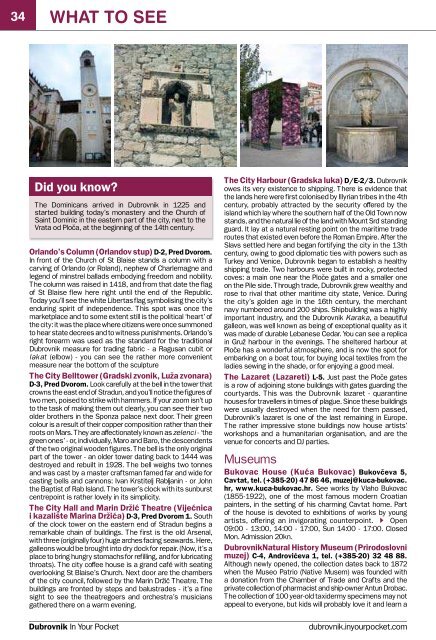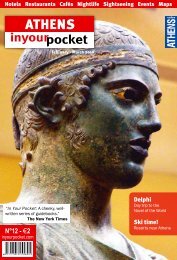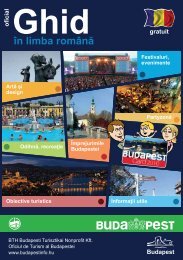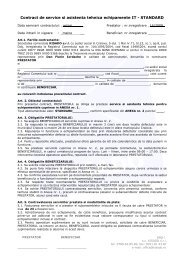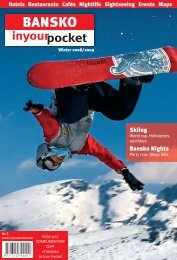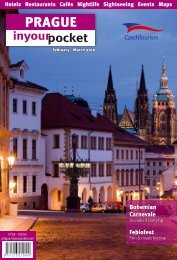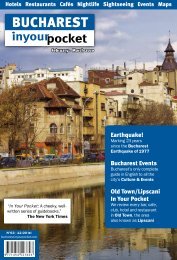DUBROVNIK - KISADO
DUBROVNIK - KISADO
DUBROVNIK - KISADO
You also want an ePaper? Increase the reach of your titles
YUMPU automatically turns print PDFs into web optimized ePapers that Google loves.
34 WHat to see<br />
WHat to see<br />
35<br />
Did you know?<br />
The Dominicans arrived in Dubrovnik in 1225 and<br />
started building today’s monastery and the Church of<br />
Saint Dominic in the eastern part of the city, next to the<br />
Vrata od Ploča, at the beginning of the 14th century.<br />
Orlando’s Column (Orlandov stup) D-2, Pred Dvorom.<br />
In front of the Church of St Blaise stands a column with a<br />
carving of Orlando (or Roland), nephew of Charlemagne and<br />
legend of minstrel ballads embodying freedom and nobility.<br />
The column was raised in 1418, and from that date the flag<br />
of St Blaise flew here right until the end of the Republic.<br />
Today you’ll see the white Libertas flag symbolising the city’s<br />
enduring spirit of independence. This spot was once the<br />
marketplace and to some extent still is the political ‘heart’ of<br />
the city: it was the place where citizens were once summoned<br />
to hear state decrees and to witness punishments. Orlando’s<br />
right forearm was used as the standard for the traditional<br />
Dubrovnik measure for trading fabric - a Ragusan cubit or<br />
lakat (elbow) - you can see the rather more convenient<br />
measure near the bottom of the sculpture<br />
The City Belltower (Gradski zvonik, Luža zvonara)<br />
D-3, Pred Dvorom. Look carefully at the bell in the tower that<br />
crowns the east end of Stradun, and you’ll notice the figures of<br />
two men, poised to strike with hammers. If your zoom isn’t up<br />
to the task of making them out clearly, you can see their two<br />
older brothers in the Sponza palace next door. Their green<br />
colour is a result of their copper composition rather than their<br />
roots on Mars. They are affectionately known as zelenci - ‘the<br />
green ones’ - or, individually, Maro and Baro, the descendents<br />
of the two original wooden figures. The bell is the only original<br />
part of the tower - an older tower dating back to 1444 was<br />
destroyed and rebuilt in 1928. The bell weighs two tonnes<br />
and was cast by a master craftsman famed far and wide for<br />
casting bells and cannons: Ivan Krstitelj Rabljanin - or John<br />
the Baptist of Rab Island. The tower’s clock with its sunburst<br />
centrepoint is rather lovely in its simplicity.<br />
The City Hall and Marin Držić Theatre (Vijećnica<br />
i kazalište Marina Držića) D-3, Pred Dvorom 1. South<br />
of the clock tower on the eastern end of Stradun begins a<br />
remarkable chain of buildings. The first is the old Arsenal,<br />
with three (originally four) huge arches facing seawards. Here,<br />
galleons would be brought into dry dock for repair. (Now, it’s a<br />
place to bring hungry stomachs for refilling, and for lubricating<br />
throats). The city coffee house is a grand café with seating<br />
overlooking St Blaise’s Church. Next door are the chambers<br />
of the city council, followed by the Marin Držić Theatre. The<br />
buildings are fronted by steps and balustrades - it’s a fine<br />
sight to see the theatregoers and orchestra’s musicians<br />
gathered there on a warm evening.<br />
The City Harbour (Gradska luka) D/E-2/3. Dubrovnik<br />
owes its very existence to shipping. There is evidence that<br />
the lands here were first colonised by Illyrian tribes in the 4th<br />
century, probably attracted by the security offered by the<br />
island which lay where the southern half of the Old Town now<br />
stands, and the natural lie of the land with Mount Srđ standing<br />
guard. It lay at a natural resting point on the maritime trade<br />
routes that existed even before the Roman Empire. After the<br />
Slavs settled here and began fortifying the city in the 13th<br />
century, owing to good diplomatic ties with powers such as<br />
Turkey and Venice, Dubrovnik began to establish a healthy<br />
shipping trade. Two harbours were built in rocky, protected<br />
coves: a main one near the Ploče gates and a smaller one<br />
on the Pile side. Through trade, Dubrovnik grew wealthy and<br />
rose to rival that other maritime city state, Venice. During<br />
the city’s golden age in the 16th century, the merchant<br />
navy numbered around 200 ships. Shipbuilding was a highly<br />
important industry, and the Dubrovnik Karaka, a beautiful<br />
galleon, was well known as being of exceptional quality as it<br />
was made of durable Lebanese Cedar. You can see a replica<br />
in Gruž harbour in the evenings. The sheltered harbour at<br />
Ploče has a wonderful atmosphere, and is now the spot for<br />
embarking on a boat tour, for buying local textiles from the<br />
ladies sewing in the shade, or for enjoying a good meal.<br />
The Lazaret (Lazareti) L-5. Just past the Ploče gates<br />
is a row of adjoining stone buildings with gates guarding the<br />
courtyards. This was the Dubrovnik lazaret - quarantine<br />
houses for travellers in times of plague. Since these buildings<br />
were usually destroyed when the need for them passed,<br />
Dubrovnik’s lazaret is one of the last remaining in Europe.<br />
The rather impressive stone buildings now house artists’<br />
workshops and a humanitarian organisation, and are the<br />
venue for concerts and DJ parties.<br />
Museums<br />
Bukovac House (Kuća Bukovac) Bukovčeva 5,<br />
Cavtat, tel. (+385-20) 47 86 46, muzej@kuca-bukovac.<br />
hr, www.kuca-bukovac.hr. See works by Vlaho Bukovac<br />
(1855-1922), one of the most famous modern Croatian<br />
painters, in the setting of his charming Cavtat home. Part<br />
of the house is devoted to exhibitions of works by young<br />
artists, offering an invigorating counterpoint. Q Open<br />
09:00 - 13:00, 14:00 - 17:00, Sun 14:00 - 17:00. Closed<br />
Mon. Admission 20kn.<br />
DubrovnikNatural History Museum (Prirodoslovni<br />
muzej) C-4, Androvićeva 1, tel. (+385-20) 32 48 88.<br />
Although newly opened, the collection dates back to 1872<br />
when the Museo Patrio (Native Musem) was founded with<br />
a donation from the Chamber of Trade and Crafts and the<br />
private collection of pharmacist and ship-owner Antun Drobac.<br />
The collection of 100 year-old taxidermy specimens may not<br />
appeal to everyone, but kids will probably love it and learn a<br />
lot too, and the museum is not so big to keep you on foot for<br />
hours. Other rooms are used for temporary exhibitions which<br />
currently include photography by the Croatian Biospeliological<br />
Society of the cave life of the Dubrovnik region. QOpen<br />
10:00 - 14:00. Closed Sat, Sun. Admission free.<br />
Ethnographic Museum Rupe (Etnografski muzej<br />
Rupe) B-3, Od Rupa 3, tel. (+385-20) 32 30 13. “Rupe”<br />
is named after the pits which were hewn out of living rock in<br />
this granary, which was used for drying and storing imported<br />
grain for the city’s people. Built in 1590, this is a fascinating<br />
building in itself, and the exhibits showcase the economic,<br />
cultural and spiritual development of Dubrovnik. The folk<br />
costumes and textiles give the best flavour of the region<br />
where folk culture is still celebrated. QOpen 09:00 - 16:00.<br />
Closed Tue. Admission 20-40kn.<br />
Maritime Museum (Pomorski muzej) E-4, St. John’s<br />
fortress (Tvrđava sv. Ivana), tel. (+385-20) 32 39 04.<br />
Considering how vital sailing and shipbuilding were to the<br />
growth of the Dubrovnik Republic, this is one of the city’s<br />
most important museums. The display of models of the fine<br />
galleons that were once built here is the stuff of fairytales -<br />
they, along with blueprints from the archives, were used for<br />
building the replicas that you might glimpse in the Gruž harbour<br />
today. Along with the Aquarium, the Museum is housed in<br />
the massive St John’s fortress on the old harbour. QOpen<br />
09:00 - 16:00. Closed Mon. Admission 20-40kn.<br />
Modern History Museum (Muzej suvremene<br />
povijesti) B-2, Poljana Paska Miličevića 1, tel. (+385-<br />
20) 32 48 56. The Museum’s work focuses on gathering<br />
documentation on contemporary history since World War<br />
Two, including memoirs and photography. From time to time<br />
you can see their exhibitions in The Rector’s Palace. The<br />
museum doesn’t have a permanent display but occasional<br />
exhibitions.<br />
The Archeological Museum (Arheološki muzej)<br />
D-4, Braće Andrijića 7, tel. (+385-20) 32 40 41,<br />
arheoloski.muzej@du.htnet.hr. The Archeological museum<br />
currently does not have a permanent residence, and some<br />
of its collections are still under preparation, but you can see<br />
objects dating back to prehistoric times excavated from the<br />
Old Town itself, including fragments of early Romanesque<br />
churches featuring the attractive plaitwork typical for<br />
Dalmatia. A prehistoric ceramic pot and female bust were<br />
found on the Pelješac peninsula. The museum doesn’t have<br />
a permanent display but occasional exhibitions.<br />
Romance on Porporela<br />
One of the favourite romantic strolls of the people of<br />
Dubrovnik is along the breakwater which is given the<br />
feminine name Porporela, by St John’s fortress. With<br />
benches overlooking the old harbour and Lokrum island<br />
while the waves lap around, it’s easy to see why so many<br />
songs have been written about this place and why so<br />
many couples have fallen in love here…<br />
The Aquarium<br />
The Aquarium (Akvarij) E-3, Kneza Damjana Jude<br />
12, tel. (+385-20) 32 39 78. Housed in the magnificent<br />
St John’s fortress (Sveti Ivan), the Aquarium gives you the<br />
chance to get to know the sea life of the Adriatic without<br />
having to eat it. Children will love it; animal rights activists<br />
may be less than impressed. QOpen 10:00 - 13:00.<br />
Closed Mon. Open 10:00 - 13:00. Closed Mon, holidays.<br />
Admission 10 - 30kn.<br />
Eugen Miljan<br />
The Birthplace of Marin Držić (Dom Marina Držića)<br />
B-3, Široka 7, tel. (+385-20) 32 32 42/(+385-20) 32<br />
32 96. This picturesque gothic town house is the place<br />
where Marin Držić was born. Držić only became accepted<br />
as one of the greats of Croatian literature after his death,<br />
as he was a bit too much of a wild card. His many exploits<br />
included sending a series of letters to the Medici family in<br />
Florence, seeking their help in overthrowing the Dubrovnik<br />
government, convinced that it was run by elitist autocrats.<br />
He is best loved for his satirical plays, and he is regarded<br />
as one of the greats of European renaissance literature. His<br />
birthplace has been transformed into an in situ exhibition<br />
of the playwright, whose comedies are regularly performed<br />
at the Dubrovnik Summer Festival. QOpen 10:00 - 17:00.<br />
Closed Mon. Admission 10 -20kn.<br />
The Synagogue and Jewish Museum (Sinagoga<br />
i židovski muzej) D-2, Žudioska 5, tel. (+385-20) 32<br />
10 28. The Synagogue (1352, the second oldest in Europe<br />
after Prague) and Jewish museum are set in a building which<br />
could be reached from within the surrounding houses in what<br />
was once the Jewish ghetto. A permanent Jewish community<br />
here was founded at the end of the 15th century following the<br />
exodus from Portugal and Spain. The community flourished<br />
and included respected doctors, merchants and state<br />
representatives. Jews in Dubrovnik enjoyed relative freedom,<br />
but there were some restrictions on their activities at certain<br />
points in history. The Synagogue is tiny and delightful, with<br />
heavy velvet drapes and a richly painted, midnight blue<br />
ceiling. The museum contains valuable menorahs and Torah<br />
scrolls, alongside information on the history of the Jewish<br />
community in Dubrovnik. QOpen 10:00 - 13:00. Closed<br />
Sat, Sun. Admission 15kn.<br />
St. Mary Altar, Art restoration and conservation Depatment<br />
of Academy of fine arts Zagreb<br />
Dubrovnik In Your Pocket<br />
dubrovnik.inyourpocket.com<br />
dubrovnik.inyourpocket.com<br />
Winter 2009 - Spring 2010


